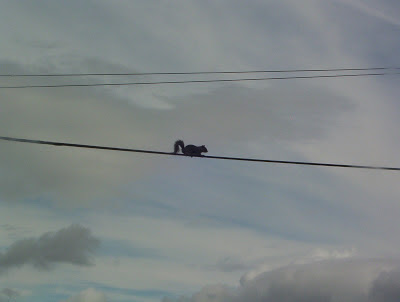when milk was delivered to your doorstep in glass bottles?
when a film (sometimes two films) plus a short feature, a cartoon and a newsreel were all included in a night at the cinema?
when the commercial station Radio Luxembourg was famous for its broadcasts of popular music?
when very often two homes had to share a phone line?
when the usual way of getting a TV set was not to buy one, but to get it on rental? A weekly visit to the TV shop with the payments book was a must.
when there was just one TV channel?
when the TV was switched on before the start of the scheduled programmes, this test card was displayed on the screen?
-o0o-
IF YOU REMEMBER (as I do)
street lamps lit by gas, horse-driven vans, Harry Lauder on the wireless, Mrs Simpson who was the cause of Edward VIII's abdication, the launch of the Queen Mary at Clydebank, the Lambeth Walk and young ladies sporting the earphone hairstyle
-o0o-
The photo below was taken around 1940. It shows my grandfather John Armour Jaap in the dress of the Ancient Order of Shepherds. I know he was a member of that benevolent society, though I don’t think he held any office. Perhaps he got dressed up like that, just for a bit of fun.
Born in 1868 in Kilmarnock, he married Charlotte Graham in 1891 in Kirkintilloch, where he had found work in the local coal mine. Later he became an engine driver, driving the “pug” which carried the coal wagons to nearby foundries and to the canal depot.
I remember, when I was a boy, my father telling me in all seriousness that Grandpa had once seen a fairy down the mine. I had no reason to doubt the story then, but I’m surprised that, when I was older, I didn’t ask my grandfather about it.
Many years ago I came across a magazine article about the supernatural and was interested to find how many well-known people, particularly in the literary world, were believers in the Wee Folk.
Towards the end of the 19th century W. B. Yeats and Lady Augusta Gregory began collecting fairy stories, and became convinced that the existence of fairies was a reality.
Another believer was G. K. Chesterton. He wrote “It is a fact that it is not abnormal men like artists, but normal men like peasants, who have borne witness a thousand times to such things. It is the farmers who see the fairies. It is the farm labourer who calls a spade a spade who also calls a spirit a spirit. It is the woodcutter with no axe to grind who will say that he saw a man hang on the gallows and afterwards hang round it as a ghost.”
-o0o-
-o0o-
A pale, untidy moon
Peers fearfully from a lurid sky
Through tattered cloud curtains of blackening grey.
The wind blows furiously
Carrying litter, leaving trees
Leafless and tottering in its wake.
And grey sea walls tower,
Pause, leap and plunge
Endlessly and mercilessly on slimy roads.
-o0o-
Section 4. PRACTICAL CRITICISM
Finally, some photos of me, between the ages of 2 to 12
-o0o-
Among my memories of childhood one incident is still very clear in my mind.
In the 1930s there was an outbreak of scarlet fever, a very infectious disease which necessitated patients being isolated in hospital. I fell victim to it, and, after I recovered and home again, my sister, just a few weeks short of her 5th birthday, caught the germ.
I can remember the day she was taken away. After the van had left I couldn't find my mother and I searched the house. And then I discovered her - the sitting room door was wide open and there she was, hiding behind the door, crying . . .
This looks very like the dreaded "fever van"
I can remember the day she was taken away. After the van had left I couldn't find my mother and I searched the house. And then I discovered her - the sitting room door was wide open and there she was, hiding behind the door, crying . . .
When our daughters were at Lenzie Academy, they made contributions to the school magazine. Here are examples beginning with a poem by Margaret - Class 1A
STORMA pale, untidy moon
Peers fearfully from a lurid sky
Through tattered cloud curtains of blackening grey.
The wind blows furiously
Carrying litter, leaving trees
Leafless and tottering in its wake.
And grey sea walls tower,
Pause, leap and plunge
Endlessly and mercilessly on slimy roads.
-o0o-
A poem by Lesley - Class 1A
PATIENCE
I sit, waiting
For thoughts to be transformed
Into words,
Waiting
For pen to touch paper:
Waiting, waiting
I sit, waiting
For thoughts to be transformed
Into words,
Waiting
For pen to touch paper:
Waiting, waiting
-o0o-
And something completely different from Fiona - Class V
Section 4. PRACTICAL CRITICISM
Read or sing this poem and answer the questions that follow in English.
NB. Answer EITHER questions 1, 4, 2, 6, OR 2, 5, 3a, 9, BUT if you choose question 7 do not attempt questions 8, 2, 6. Do not attempt question 5b if you are of a nervous disposition.
Baa, baa, black sheep
Have you any wool?
Yes, sir, yes, sir,
Three bags full.
One for the master,
And one for the dame,
And one for the little boy
Who lives down the lane.
- Anon
-o0o-Finally, some photos of me, between the ages of 2 to 12
-o0o-
TODAY'S POST CONCLUDES THIS SERIES.
However it will be replaced by a new blog
90PLUS AND STILL BLOGGING
which begins next Saturday 24th June
-o=0=o-
However it will be replaced by a new blog
90PLUS AND STILL BLOGGING
which begins next Saturday 24th June
-o=0=o-





















































